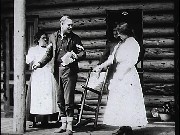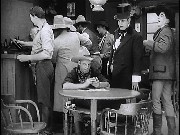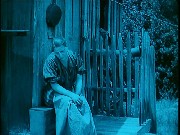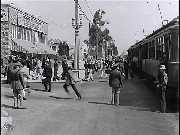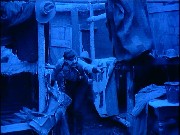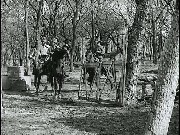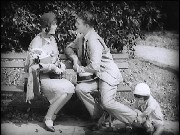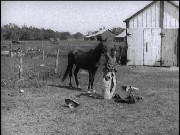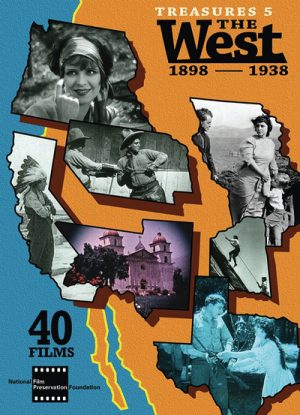
Treasures 5 brings together 40 early movies showing the West as it’s never been seen on DVD. The 10-hour, 3-disc anthology has plenty of Westerns, including examples with pistol-packing heroines; comic cowboys; Hispanic, Native American, and Asian stars; lawmen restaging their exploits, and America's first cowboy screen celebrities Broncho Billy Anderson and Tom Mix. With the West’s younger days still fresh in filmmakers’ minds, these narratives surprise today with their effortless authenticity—in dress, gesture, props, buildings, and everyday work. In addition, the set also showcases the “real West” in travelogues from 10 Western states; newsreels about Native Americans; and documentaries about such Western subjects as cattle ranching in Santa Monica; riding the rails; how vaqueros made horsehair ropes; the birth of the canned fruit industry; and the beginning of the water wars. There are lots of surprises and a few genuine masterworks, including Mantrap (1926), with an utterly bewitching Clara Bow in her most sophisticated role, and W.S. Van Dyke's The Lady of the Dugout (1918), with outlaw-turned-actor Al Jennings playing himself 20 years earlier.
3 x DVD9 | NTSC 4:3 | 596 min | 22 Gb + 3% rec
Language: English intertitles
Subtitles: none

Some set highlights:
• The Mack Sennett comedy "The Tourists" (1912) concerns privileged white people, especially comedienne Mabel Normand (who later worked in Charlie Chaplin films), buying crafts — and causing an uproar — in a Navaho community near an Albuquerque train station. Real-life Indians are mixed in with Sennett's actors; there are shots of Asdzaa Lichii, a then-renowned weaver, doing her thing.
• The romantic drama in "The Sergeant" (1910) is upstaged by magnificent Yosemite backgrounds. "The Sergeant" was lost until last year, thus unseen for a century.
• "The Sunshine Gatherers" (1921) is a promotional film for Del Monte that begins with a depiction of 18th-century Spanish missionary Junipero Serra, and ends with food porn — mouth-watering desserts concocted with canned fruit, lovingly photographed in an early two-color process.
• "Deschutes Driftwood" (1916) and "The 'Promised Land' Barred to 'Hobos' " (1936) examine the phenomenon of "hobos," who, commentator Todd DePastino notes, were not necessarily drifters, but men who traveled from work site to work site. "Driftwood" is a travelogue using a real-life hobo as its host; "Promised Land" is a newsreel about unemployed people being barred from entering California, an unprecedented action later depicted in John Steinbeck's "The Grapes of Wrath."
• "Last of the Line" (1914) is a two-reel drama from a Native American perspective in which Japanese actor Sessue Hayakawa plays the corrupted son of a noble Sioux chief (Joe Goodboy). Hayakawa would receive an Oscar nod for "Bridge on the River Kwai" (1957).
• "Broncho Billy and the Schoolmistress" (1912) is a humorous entry in a series of more than 125 Broncho Billy films starring Gilbert M. Anderson.
• "Mantrap" (1926) is a romantic-triangle comedy starring "It girl" Clara Bow and directed by Victor Fleming ("The Wizard of Oz"). Mantrap doesn't refer to Bow's alluring behavior (though it could), but to a remote, woodsy Canadian destination where city slickers get away from it all. Bow is a "flapper" stuck in the wilderness, a city girl married to a burly local shopkeeper (Ernest Torrance). She perks up when introduced to a visiting lawyer from New York City (Percy Marmont), who came to Mantrap to get away from girls like her.
• "The Lady of the Dugout" (1918) is a true curio — a film about real-life outlaw Al Jennings produced, co-written and starring Jennings as himself. The commentary includes audio clips from an interview with Jennings taped in 1957, when he was 94. He says of his association with Billy the Kid: "We rode, we shot, we killed, we robbed." Jennings became interested in storytelling thanks to a onetime cellmate: O. Henry.
Treasures5.West.L.D1.part1.rar
Treasures5.West.L.D1.part2.rar
Treasures5.West.L.D2.part1.rar
Treasures5.West.L.D2.part2.rar
Treasures5.West.L.D3.part1.rar
Treasures5.West.L.D3.part2.rar
